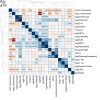Stress, Hyperglycemia, and Insulin Resistance Correlate With Neutrophil Activity and Impact Acute Myocardial Infarction Outcomes
- PMID: 39100008
- PMCID: PMC11295428
- DOI: 10.7759/cureus.63731
Stress, Hyperglycemia, and Insulin Resistance Correlate With Neutrophil Activity and Impact Acute Myocardial Infarction Outcomes
Abstract
Introduction Acute insulin resistance (IR) and hyperglycemia are frequently observed during acute myocardial infarction (AMI), significantly influencing both immediate and long-term patient outcomes, irrespective of diabetic status. Neutrophilia and increased neutrophil activity, which are common in these scenarios, have been associated with poorer prognoses, as demonstrated in our recent findings. While it is well established that neutrophils and stress-induced hyperglycemia exacerbate inflammation and hinder recovery, the complex interplay between these factors and their combined impact on AMI prognosis remains inadequately understood. This study aims to investigate the effects of stress hyperglycemia and IR on AMI patients at the onset of the event and to elucidate the relationship between these metabolic disturbances and inflammatory markers, particularly neutrophils. Methods We conducted a longitudinal prospective study on 219 AMI patients at Elias Emergency Hospital in Bucharest, Romania, from April 2021 to September 2022. Patients were included within 24 hours of AMI with ST-segment elevation and excluded if they had acute infections or chronic inflammatory diseases. Blood samples were collected to study inflammatory biomarkers, including neutrophil extracellular traps (NETs), S100A8/A9, interleukin (IL)-1β, IL-18, and IL-6. Diabetic and pre-diabetic statuses were defined using glycated hemoglobin (HbA1c) and medical history (ADA 2019 criteria). To assess glycemic parameters, we employed the glycemia ratio (GR) and the homeostatic model assessment of insulin resistance (HOMA-IR) index, enabling a precise evaluation of stress hyperglycemia, acute IR, and their prognostic implications. Patients were stratified into groups based on GR calculations, categorized as under-average glycemia, normal glycemia, and stress hyperglycemia. Results The majority of patients in the stress hyperglycemia group exhibited an unfavorable prognosis. This group also demonstrated significantly elevated neutrophil counts and neutrophil-to-lymphocyte ratios (NLR). The GR was significantly and positively correlated with inflammation markers, including neutrophil count (Pearson's R = 0.181, P = 0.008) and NLR (Pearson's R = 0.318, P < 0.001), but showed no significant correlation with other evaluated inflammatory markers. Conclusions Our findings suggest that poor outcomes in AMI patients may be associated with stress hyperglycemia, as indicated by GR. AcuteIR, quantified by GR and HOMA-IR, exhibits a strong correlation with neutrophil count and NLR within the first 24 hours of AMI onset. However, no significant correlation was observed with other inflammatory markers, such as IL-1β, IL-18, and IL-6, underscoring the specific interplay between IR and neutrophil activity in this setting.
Keywords: acute insulin resistance; acute myocardial infarction; inflammatory markers; neutrophil-to-lymphocyte ratio; stress hyperglicemia.
Copyright © 2024, Barbu et al.
Conflict of interest statement
Human subjects: Consent was obtained or waived by all participants in this study. Ethics Committee of Elias Emergency Hospital, Bucharest, Romania issued approval (3349/06.05.2021). Informed consent was obtained from the participants as per the Declaration of Helsinki guidelines. Animal subjects: All authors have confirmed that this study did not involve animal subjects or tissue. Conflicts of interest: In compliance with the ICMJE uniform disclosure form, all authors declare the following: Payment/services info: This work was supported by Romania’s National Recovery and Resilience Plan, European Union - NextGenerationEU"; PNRR-III-C9-2022-I8, CF 93/15.11.2022, financing contract no. 760063/23.05.2023. Financial relationships: All authors have declared that they have no financial relationships at present or within the previous three years with any organizations that might have an interest in the submitted work. Other relationships: All authors have declared that there are no other relationships or activities that could appear to have influenced the submitted work.
Figures





Similar articles
-
Infarct size, inflammatory burden, and admission hyperglycemia in diabetic patients with acute myocardial infarction treated with SGLT2-inhibitors: a multicenter international registry.Cardiovasc Diabetol. 2022 May 15;21(1):77. doi: 10.1186/s12933-022-01506-8. Cardiovasc Diabetol. 2022. PMID: 35570280 Free PMC article.
-
Hyperglycemia, inflammatory response and infarct size in obstructive acute myocardial infarction and MINOCA.Cardiovasc Diabetol. 2021 Feb 2;20(1):33. doi: 10.1186/s12933-021-01222-9. Cardiovasc Diabetol. 2021. PMID: 33530978 Free PMC article.
-
Neutrophil-to-lymphocyte Ratio and Its Relation with Markers of Inflammation and Myocardial Necrosis in Patients with Acute Coronary Syndrome.Med Arch. 2017 Oct;71(5):312-315. doi: 10.5455/medarh.2017.71.312-315. Med Arch. 2017. PMID: 29284896 Free PMC article.
-
Proposal of a New Approach to Study and Categorize Stress Hyperglycemia in Acute Myocardial Infarction.J Emerg Med. 2016 Jul;51(1):31-6. doi: 10.1016/j.jemermed.2015.03.047. Epub 2016 Mar 31. J Emerg Med. 2016. PMID: 27041491 Review.
-
From immune response to mental health: neutrophils in schizophrenia.Ann Med Surg (Lond). 2024 Nov 12;87(3):1360-1369. doi: 10.1097/MS9.0000000000002744. eCollection 2025 Mar. Ann Med Surg (Lond). 2024. PMID: 40213199 Free PMC article. Review.
Cited by
-
The additive effect of the stress hyperglycemia ratio on type 2 diabetes: a population-based cohort study.Cardiovasc Diabetol. 2025 Jan 6;24(1):5. doi: 10.1186/s12933-024-02567-7. Cardiovasc Diabetol. 2025. PMID: 39762918 Free PMC article.
References
-
- Admission hyperglycemia and acute myocardial infarction: outcomes and potential therapies for diabetics and nondiabetics. Chakrabarti AK, Singh P, Gopalakrishnan L, et al. https://onlinelibrary.wiley.com/doi/10.1155/2012/704314. Cardiol Res Pract. 2012;2012:704314. - PMC - PubMed
-
- Neurohumoral response and stress hyperglycemia in myocardial infarction. Swieszkowski SP, Costa D, Aladio JM, et al. https://pubmed.ncbi.nlm.nih.gov/36345108/ J Diabetes Complications. 2022;36:108339. - PubMed
-
- Stress hyperglycaemia and increased risk of death after myocardial infarction in patients with and without diabetes: a systematic overview. Capes SE, Hunt D, Malmberg K, Gerstein HC. http://www.thelancet.com/article/S0140673699084159/fulltext. Lancet. 2000;355:773–778. - PubMed
LinkOut - more resources
Full Text Sources
Research Materials
Miscellaneous
